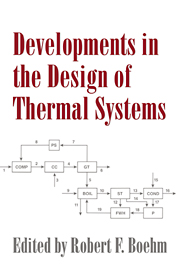Book contents
- Frontmatter
- Contents
- Preface
- Biographical sketches of the authors
- 1 Introduction and trends in the thermal design field
- 2 Computer-aided process design trends in the power industry
- 3 Automated design of chemical process plants
- 4 Thermophysical properties for design simulations
- 5 Introduction to Pinch Analysis
- 6 Second Law applications in thermal system design
- 7 Thermodynamic optimization of heat transfer and fluid flow processes
- 8 An introduction of thermoeconomics
- 9 Artificial intelligence in thermal systems design: concepts and applications
- Subject Index
- Author Index
2 - Computer-aided process design trends in the power industry
Published online by Cambridge University Press: 23 September 2009
- Frontmatter
- Contents
- Preface
- Biographical sketches of the authors
- 1 Introduction and trends in the thermal design field
- 2 Computer-aided process design trends in the power industry
- 3 Automated design of chemical process plants
- 4 Thermophysical properties for design simulations
- 5 Introduction to Pinch Analysis
- 6 Second Law applications in thermal system design
- 7 Thermodynamic optimization of heat transfer and fluid flow processes
- 8 An introduction of thermoeconomics
- 9 Artificial intelligence in thermal systems design: concepts and applications
- Subject Index
- Author Index
Summary
Introduction
Competition within the power industry has encouraged industry developers, suppliers, and operators to reexamine options for providing cost-effective electricity. One approach to improving generation efficiency involves system optimization and evaluation using process analysis tools. These tools are used to evaluate factors such as plant performance, environmental emissions, and controllability. A systems approach, based on computer-aided process analysis, provides an ideal tool for use in quantifying costs, benefits, and risk in power generation development projects.
A power plant model can be as simple or as complex as is necessary to address the needs of the analysis. System models can be limited to predicting the release of heat during fuel combustion or can include detailed representations of fuel handling, preparation, consumption, and emission processes as illustrated in Fig. 2.1. Power consumption resulting from auxiliary systems can be identified, and performance sensitivity to component behavior can be quantified. Specific subsystems and components can be modeled to answer specific risk-related questions.
Such modeling is increasingly being used to answer project development questions, direct repowering and refurbishing projects, and optimize plant operations. Instrumental in this trend is the use of computer-aided process design tools that provide an efficient and capable means for the system designer and system developer to accomplish these goals.
Process simulators were originally used in the chemical and petroleum industries on large stand-alone mainframe computers. Now, with recent advances in computer technology, significantly more powerful and more user-friendly programs are available for even the smallest portable laptop computers.
- Type
- Chapter
- Information
- Developments in the Design of Thermal Systems , pp. 16 - 39Publisher: Cambridge University PressPrint publication year: 1997



